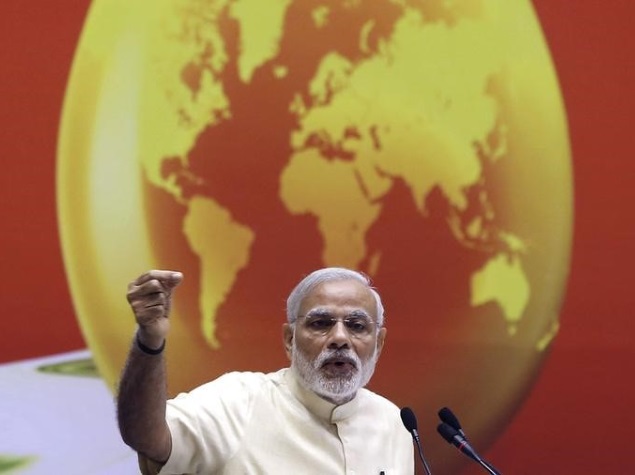- Home
- Internet
- Internet Features
- After Wi Fi at Taj Mahal, Narendra Modi Revives Campaign for 'Digital India'
After Wi-Fi at Taj Mahal, Narendra Modi Revives Campaign for 'Digital India'

The government's tech push, which plans to provide electronic governance and universal phone connectivity across the country, aims to bridge India's digital divide, bringing in large investments in technology manufacturing.
But apart from a handful of headline-grabbing initiatives - free Wi-Fi at the Taj Mahal, for example - the push to connect India and drive a national fibre optic network, first approved by the last government in 2011, has made slow progress.
(Also see: Narendra Modi Launches 'Digital India Week' to Empower Citizens via IT)
"Now we are at a place where we can take off," said a spokesman for Communications and Information Technology Minister Ravi Shankar Prasad. "The idea is to bridge the gap between haves and have-nots of services and deliverables."
The digital week, being launched later on Wednesday, will involve citizen awareness programmes. But officials say a plan will also be announced for "billions of dollars" of investment, most likely in manufacturing - critical for a government which badly needs to create more jobs, at a faster rate.
(Also see: Reliance Industries to Invest Over Rs. 2,50,000 Crores in Digital India)
The plan aims to stop net imports of technology and electronics by 2020, while creating over 100 million jobs.
India's first cyber premier, Modi has used social media and particularly Twitter, where he has 13 million followers, to style himself as a leader in touch with technology.
(Also see: Cabinet Clears Setting Up of Online National Agriculture Market)
With a growing economy and falling handset prices, India is one of the fastest growing smartphone markets in the world, and Modi is looking to harness India's potential for social development in fields like education and health.
But the challenge is great.
India's average Internet speed was ranked 115th globally in the first quarter of the year, among countries studied by services provider Akamai Technologies.
(Also see: Reliance Group to Invest Rs. 10,000 Crores on Digital India Initiatives)
India had just a little over 100 million broadband subscribers at the end of April, out of a population of close to 1.3 billion, according to the sector regulator, which considers Internet connections with minimum download speeds of 512Kbps.
A telecom ministry panel, by comparison, said in March it wants the digital push to establish affordable broadband connectivity of 2Mbps to 20Mbps "for all households" by 2017.
© Thomson Reuters 2015
For the latest tech news and reviews, follow Gadgets 360 on X, Facebook, WhatsApp, Threads and Google News. For the latest videos on gadgets and tech, subscribe to our YouTube channel. If you want to know everything about top influencers, follow our in-house Who'sThat360 on Instagram and YouTube.
Related Stories
- Samsung Galaxy Unpacked 2025
- ChatGPT
- Redmi Note 14 Pro+
- iPhone 16
- Apple Vision Pro
- Oneplus 12
- OnePlus Nord CE 3 Lite 5G
- iPhone 13
- Xiaomi 14 Pro
- Oppo Find N3
- Tecno Spark Go (2023)
- Realme V30
- Best Phones Under 25000
- Samsung Galaxy S24 Series
- Cryptocurrency
- iQoo 12
- Samsung Galaxy S24 Ultra
- Giottus
- Samsung Galaxy Z Flip 5
- Apple 'Scary Fast'
- Housefull 5
- GoPro Hero 12 Black Review
- Invincible Season 2
- JioGlass
- HD Ready TV
- Laptop Under 50000
- Smartwatch Under 10000
- Latest Mobile Phones
- Compare Phones
- Infinix Smart 9 HD
- Lava Yuva Smart
- Samsung Galaxy S25 Ultra
- Samsung Galaxy S25+
- Samsung Galaxy S25
- Realme 14 Pro 5G
- Realme 14 Pro+ 5G
- Itel Zeno 10
- Asus Chromebook CR11
- Lenovo Yoga Slim 9i (2025)
- Asus ROG Flow Z13 (2025)
- Xiaomi Pad 7
- Titan Evolution
- Noise ColorFit Pro 6
- Sony 65 Inches Ultra HD (4K) LED Smart TV (KD-65X74L)
- TCL 55 Inches Ultra HD (4K) LED Smart TV (55C61B)
- Sony PlayStation 5 Pro
- Sony PlayStation 5 Slim Digital Edition
- Blue Star 1.5 Ton 3 Star Inverter Split AC (IC318DNUHC)
- Blue Star 1.5 Ton 3 Star Inverter Split AC (IA318VKU)
















